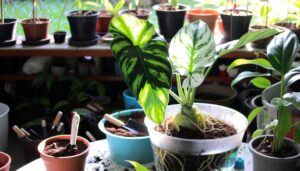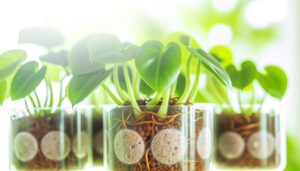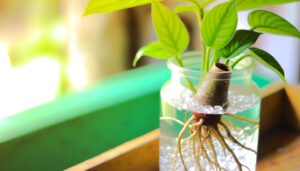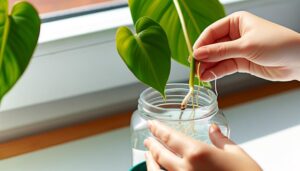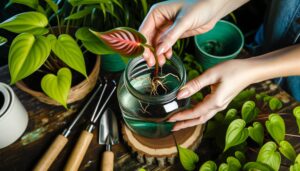How to Propagate Philodendron Minima? Step-by-Step Guide!
Propagating Philodendron Minima requires precision and proper conditions. Begin by sterilizing pruning shears and selecting healthy, resilient stems with multiple nodes.
Make a clean cut below a node and remove excess leaves to prepare the cutting. For water propagation, place the cutting in a clean glass container filled with distilled water.
For soil propagation, use a well-draining potting mix and maintain consistent moisture. Place the cutting in a bright location with indirect light and keep humidity levels between 60% and 80%.
Allow 4-6 weeks for root development before transplanting. For detailed techniques and best care, further exploration will be beneficial.
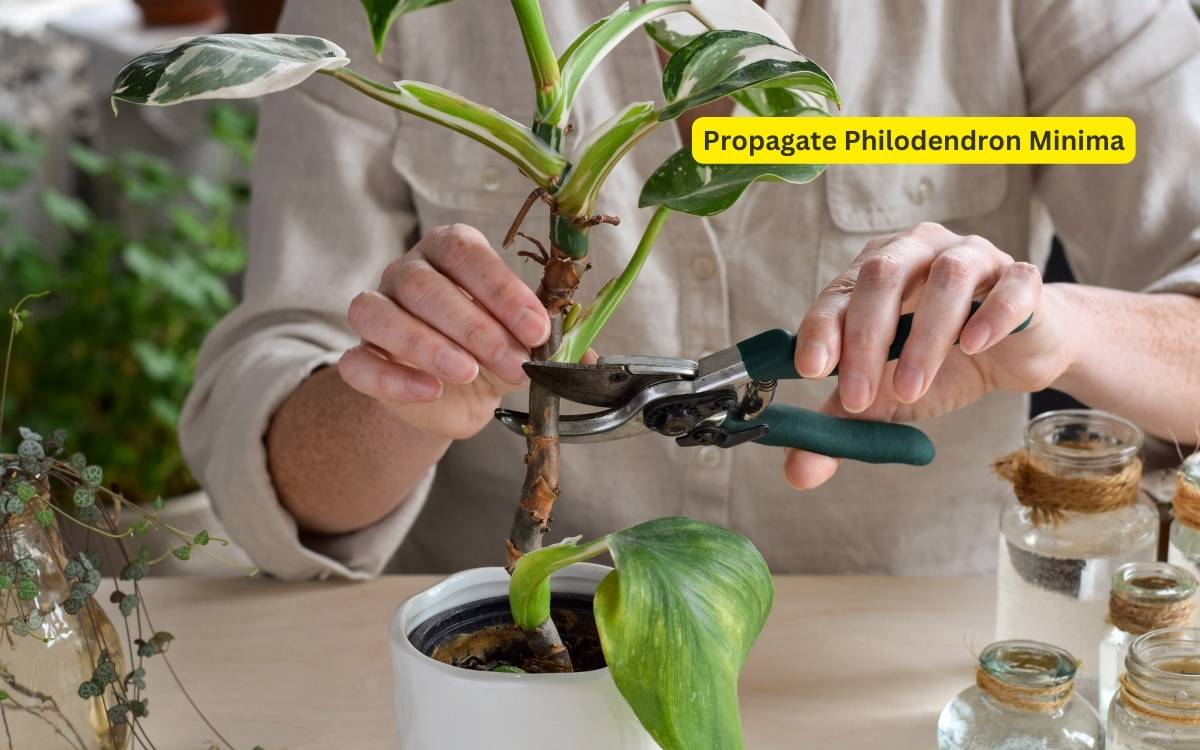
Key Takeaways
- Choose a healthy stem with at least one node and robust growth for propagation.
- Sterilize pruning shears and cut the stem below a node to prepare the cutting.
- Remove lower leaves from the cutting to reduce moisture loss and focus energy on rooting.
- Use distilled water for water propagation or a well-draining potting mix for soil propagation.
- Maintain bright, indirect light and humidity levels between 60% and 80% for optimal growth.
Gathering Your Supplies
Before starting the propagation of Philodendron Minima, it is important to carefully gather all necessary supplies to guarantee a successful and efficient process.
The foundational elements include a pair of sterilized pruning shears for precise cuts, a clean glass container for water propagation, or a pot with well-draining soil for soil propagation. Additionally, rooting hormone can be a valuable asset for promoting faster root development.
Make sure the availability of distilled or rainwater to avoid chlorine and mineral build-up, which could impede root growth. A plastic bag or a humidity dome will help maintain the required humidity levels.
Choosing a Healthy Stem
Choosing a strong stem for propagation is crucial, as the health and vigor of the parent plant greatly impact the success rate of rooting and subsequent growth. Begin by selecting stems exhibiting robust growth, characterized by a vibrant green hue and absence of discoloration or damage.
Excellent candidates should possess multiple nodes, which are the points where leaves and roots develop. Avoid stems with signs of disease, pest infestation, or mechanical injury, as these issues can hinder the propagation process. Inspect for firmness and resilience, ensuring the stem is neither too young nor excessively woody.
A healthy stem should exhibit balanced growth, with uniformly spaced nodes, indicating consistent nutrient distribution and overall plant health.
Making the Right Cut
When making the correct cut for propagating Philodendron Minima, it is vital to identify healthy nodes, as these are the points from which new roots will develop.
Utilizing sterile equipment is key to prevent the introduction of pathogens that could compromise plant health.
Employing a precise cutting technique will guarantee clean cuts that facilitate best growth during the propagation process.
Identify Healthy Nodes
To guarantee successful propagation of Philodendron Minima, it is imperative to accurately identify healthy nodes, characterized by well-developed aerial roots and robust stem segments.
Nodes are the critical points on the stem where leaves, roots, and branches originate. For propagation purposes, select nodes that exhibit visible aerial roots, as these roots will facilitate quicker establishment in new growing mediums.
Additionally, inspect the stem for any signs of disease or damage, ensuring that the chosen segment is free from discoloration or soft spots. A healthy node will typically be firm to the touch and display a vibrant green hue.
Use Sterile Equipment
Using sterile equipment is essential to prevent the introduction of pathogens and safeguard the health of the Philodendron Minima during the propagation process. Employing tools that are meticulously cleaned and disinfected ensures that harmful bacteria and fungi do not compromise the plant’s integrity.
Before making any cuts, sterilize pruning shears, scissors, or knives using a solution of one part bleach to nine parts water or by wiping them with isopropyl alcohol. This practice mitigates the risk of infection, fostering ideal conditions for successful propagation.
Additionally, maintaining sterile equipment throughout the process helps prevent the spread of any latent diseases within the plant. By adhering to these strict sterilization protocols, you enhance the likelihood of robust and healthy new growth in your propagated specimens.
Proper Cutting Technique
A precise and well-angled cut just below a node is vital for the successful propagation of Philodendron Minima. This technique guarantees that the cutting includes at least one node and an internodal section, which are essential for root development.
Utilize sharp, sterile pruning shears to prevent tissue damage and minimize infection risk. The cut should be made at a 45-degree angle to increase the surface area for water absorption and hormone uptake.
Positioning the cut in this manner maximizes the plant’s ability to heal and initiate new root growth. Following this method meticulously enhances the likelihood of a robust and healthy new plant, ensuring best results in the propagation process.
Preparing the Cutting
Prior to making the cutting, verify that the chosen Philodendron Minima stem exhibits healthy, vibrant foliage and contains at least one node. Select a segment that is free from disease or pests to support ideal growth potential.
To prepare the cutting, follow these steps:
- Sterilize Tools: Use a sharp, sanitized knife or pruning shears to prevent introducing pathogens. Disinfect using isopropyl alcohol or a bleach solution.
- Cut Below Node: Make a precise cut just below a node, as nodes are essential for root development. Ensure the cut is clean and angled to maximize surface area.
- Remove Lower Leaves: Strip any leaves from the lower part of the cutting to prevent decay when submerged in the rooting medium.
This careful preparation facilitates successful propagation.
Rooting in Water
Rooting Philodendron Minima cuttings in water begins with the meticulous preparation of the cutting, ensuring that the node, which is pivotal for root development, remains intact.
Selecting an appropriate container, preferably a transparent one, facilitates the observation of root progression.
Regular monitoring of the root growth is essential, enabling timely intervention to prevent issues such as root rot or stagnation.
Cutting Preparation
To ensure successful rooting of Philodendron Minima cuttings in water, begin by selecting a healthy stem section that has at least one node and a few leaves. This secures the cutting has the necessary components for growth.
Prepare by following these important steps:
- Sterilize your cutting tools: Use rubbing alcohol or a bleach solution to clean scissors or a knife to prevent bacterial or fungal infections.
- Cut below a node: Make a clean cut just below a node, which is the point where leaves attach to the stem. This node is essential for root development.
- Remove excess leaves: Trim away any leaves that would be submerged in water to avoid rot, ensuring only the node and a few leaves remain above water.
These steps optimize the cutting for rooting success.
Choosing Right Container
Selecting a suitable vessel is crucial for the successful rooting of Philodendron Minima cuttings in water, as it directly affects both the stability of the cutting and the availability of oxygen for root development.
A see-through glass container is recommended to monitor water clarity and root progress without disturbing the plant. The vessel should be deep enough to submerge the nodes but not the leaves, preventing rot. A slender neck can help steady the cutting, reducing the risk of tipping.
The size should accommodate a small volume of water to guarantee frequent changes, maintaining optimal oxygen levels and reducing the risk of bacterial growth. Cleanliness of the container is paramount to prevent contamination and facilitate healthy root formation.
Monitoring Root Growth
Once the appropriate container is chosen, it is crucial to meticulously track the progress of root development to secure the successful propagation of Philodendron Minima.
Monitoring root growth involves several key steps:
- Regular Inspection: Check the cuttings every few days to observe root growth, making sure roots are developing healthily without signs of rot or stagnation.
- Water Quality: Maintain clean water by changing it at least once a week. This prevents bacterial growth and supplies the cutting with fresh oxygen.
- Environmental Conditions: Ensure the container is placed in indirect sunlight and maintains a stable temperature between 65-75°F (18-24°C) to optimize root formation.
Adhering to these measures guarantees robust root development, essential for the plant’s long-term health and growth.
Rooting in Soil
Rooting Philodendron Minima in soil requires careful control over moisture levels, substrate composition, and environmental conditions to guarantee successful propagation.
Start by selecting a well-draining, aerated potting mix, ideally comprising equal parts of perlite, peat moss, and orchid bark. This promotes ideal root aeration and moisture retention.
When potting, maintain consistent soil moisture, avoiding both waterlogging and desiccation. Use a moisture meter for accurate monitoring.
Ambient temperature should remain between 70-80°F (21-27°C), as cooler temperatures inhibit root development. Humidity levels of 60-70% are best, achievable via humidity trays or misting.
Regularly check for root emergence, usually visible within 4-6 weeks. This systematic approach ensures the successful establishment of strong root systems in Philodendron Minima.
Ensuring Proper Light
Ensuring proper light is a vital factor for the successful propagation of Philodendron Minima. Ideal light conditions entail providing bright, indirect light, which facilitates robust growth and healthy development.
Conversely, direct sunlight should be avoided as it can cause leaf scorch and hinder the plant’s progress.
Optimal Light Conditions
Proper light conditions for Philodendron Minima require a balance of indirect sunlight, typically achieved through placement in an area with filtered light, away from direct sun exposure to prevent leaf scorching.
To enhance these conditions, consider the following:
- Light Intensity: Maintain medium to bright indirect light levels, ideally around 1000 to 2000 foot-candles. This can be measured using a light meter to ensure accuracy.
- Duration: Sustain a consistent light exposure of approximately 12-16 hours daily, mimicking a natural day-night cycle to promote healthy growth.
- Light Source: Use sheer curtains or blinds to diffuse natural light or utilize grow lights with a spectrum range of 400-700 nanometers for optimal photosynthesis.
These measures will promote vigorous growth and vibrant foliage.
Avoiding Direct Sunlight
Shielding Philodendron Minima from direct sunlight is essential to prevent photodamage and promote the plant thrives under ideal light conditions. Direct exposure to intense sunlight can cause leaf burn, characterized by browning or yellowing of the foliage.
This tropical plant flourishes in bright, indirect light, which mimics its natural understory habitat. Optimal light can be achieved by positioning the plant near an east or north-facing window, where it receives filtered sunlight. Alternatively, the use of sheer curtains can diffuse intense light, safeguarding the delicate leaves.
Monitoring light levels with a light meter can guarantee consistent exposure within the 10,000 to 20,000 lux range, important for photosynthesis without causing harm. This balance is crucial for vigorous growth and propagation.
Maintaining Humidity Levels
To enhance the growth environment for Philodendron Minima, it is vital to maintain humidity levels between 60% and 80%. This can be achieved through various methods such as misting, using a humidifier, or placing the plant on a pebble tray.
Consistent humidity is critical for the plant’s cellular processes and overall health.
Here are three effective methods to maintain appropriate humidity levels:
- Misting: Regularly misting the leaves can temporarily boost humidity but requires daily attention.
- Humidifier: A humidifier provides a consistent and controlled humidity level, ideal for maintaining the required range.
- Pebble Tray: Placing the plant on a tray filled with water and pebbles creates localized humidity as the water evaporates.
These methods guarantee the best growth conditions for Philodendron Minima.
Transplanting the Cutting
Transplanting the cutting requires careful attention to soil mixture, root health, and environmental conditions to guarantee successful establishment and growth. Begin by preparing a well-draining soil mix, ideally a combination of peat, perlite, and orchid bark, which promotes aeration and moisture retention.
Thoroughly examine the roots for signs of decay or illness, trimming any affected areas. Place the cutting in a pot with sufficient drainage, making sure the roots are evenly distributed.
| Factor | Recommendation |
|---|---|
| Soil Composition | Peat, perlite, and orchid bark combination |
| Root Health | Inspect and prune damaged roots |
| Pot Size | Slightly larger than the root system |
| Drainage | Confirm pot has ample drainage holes |
| Positioning | Spread roots evenly in the chosen soil mix |
Maintain peak humidity and indirect light to support adaptation.
Caring for New Growth
Fostering the healthy development of new growth in Philodendron Minima necessitates meticulous attention to watering practices, light exposure, and nutrient supplementation.
The following guidelines will help in promoting robust and vibrant new growth:
- Watering: Maintain consistent soil moisture without saturating. Use well-draining soil and water when the top inch of soil feels parched to the touch.
- Light Exposure: Position the plant in bright, indirect light. Avoid direct sunlight, which can damage leaves, yet provide sufficient light to support photosynthesis.
- Nutrient Supplementation: Apply a balanced, water-soluble fertilizer every 4-6 weeks during the growing season. Dilute to half strength to avoid excessive fertilization, which can lead to root damage and impede growth.
These measures are crucial in promoting the vigorous growth of your Philodendron Minima.
Conclusion
To wrap up, the propagation of Philodendron minima demands meticulous attention to detail, encompassing steps from selecting a robust stem to ensuring ideal environmental conditions.
Adherence to each stage, akin to the precision of a well-conducted symphony, fosters the successful cultivation of new growth.
By maintaining proper light, humidity, and careful transplantation, one nurtures the potential for thriving plants, thereby contributing to the verdant tapestry of indoor horticulture.


